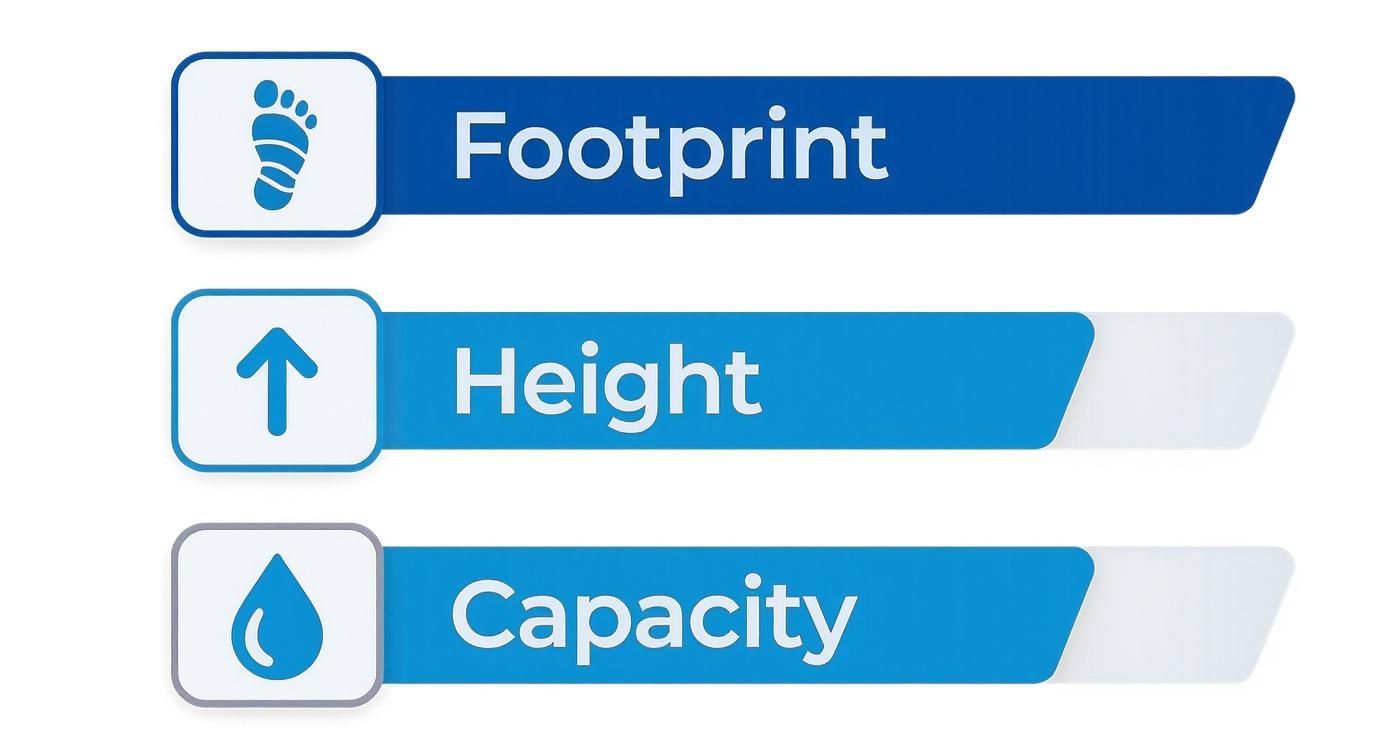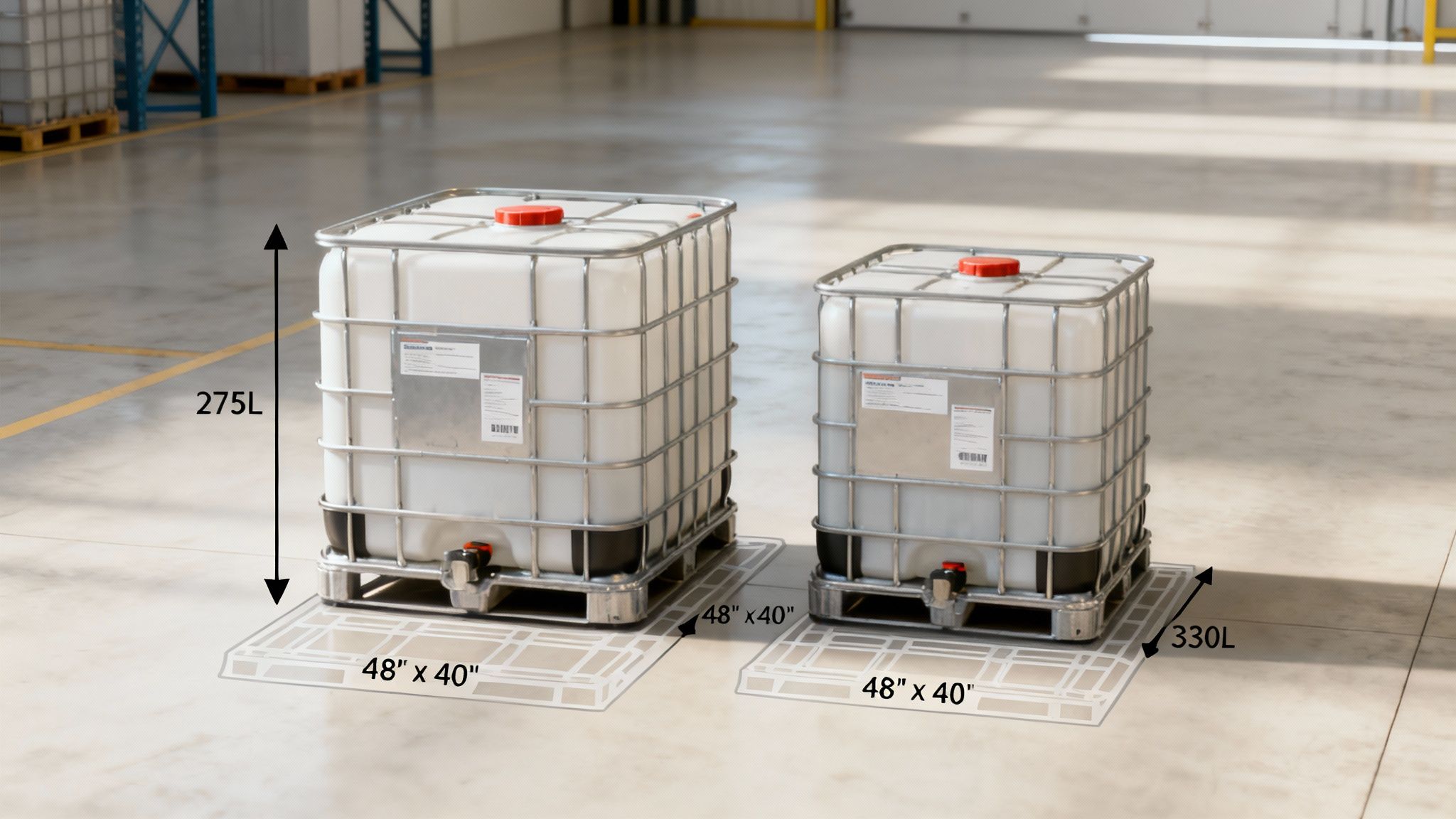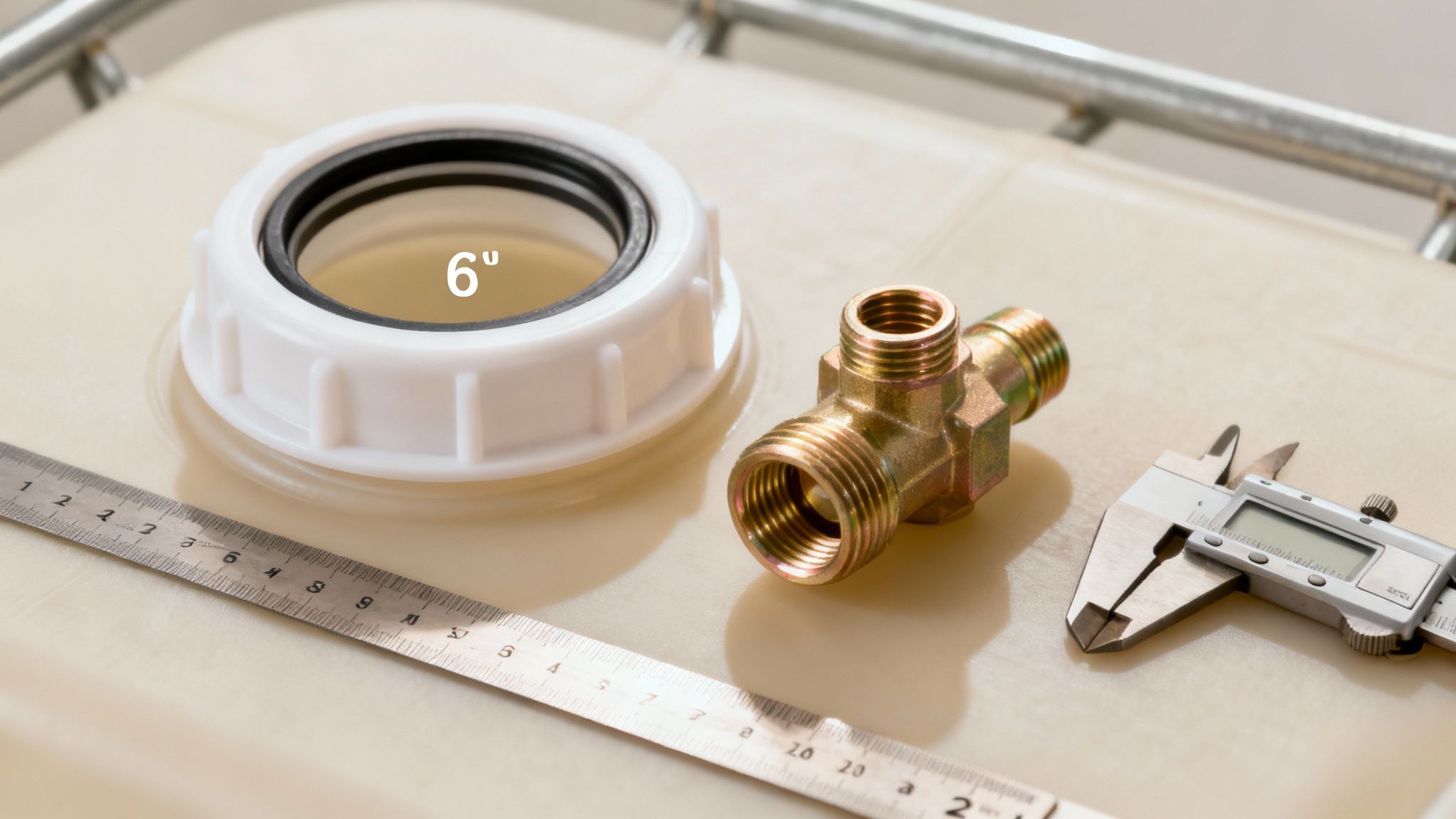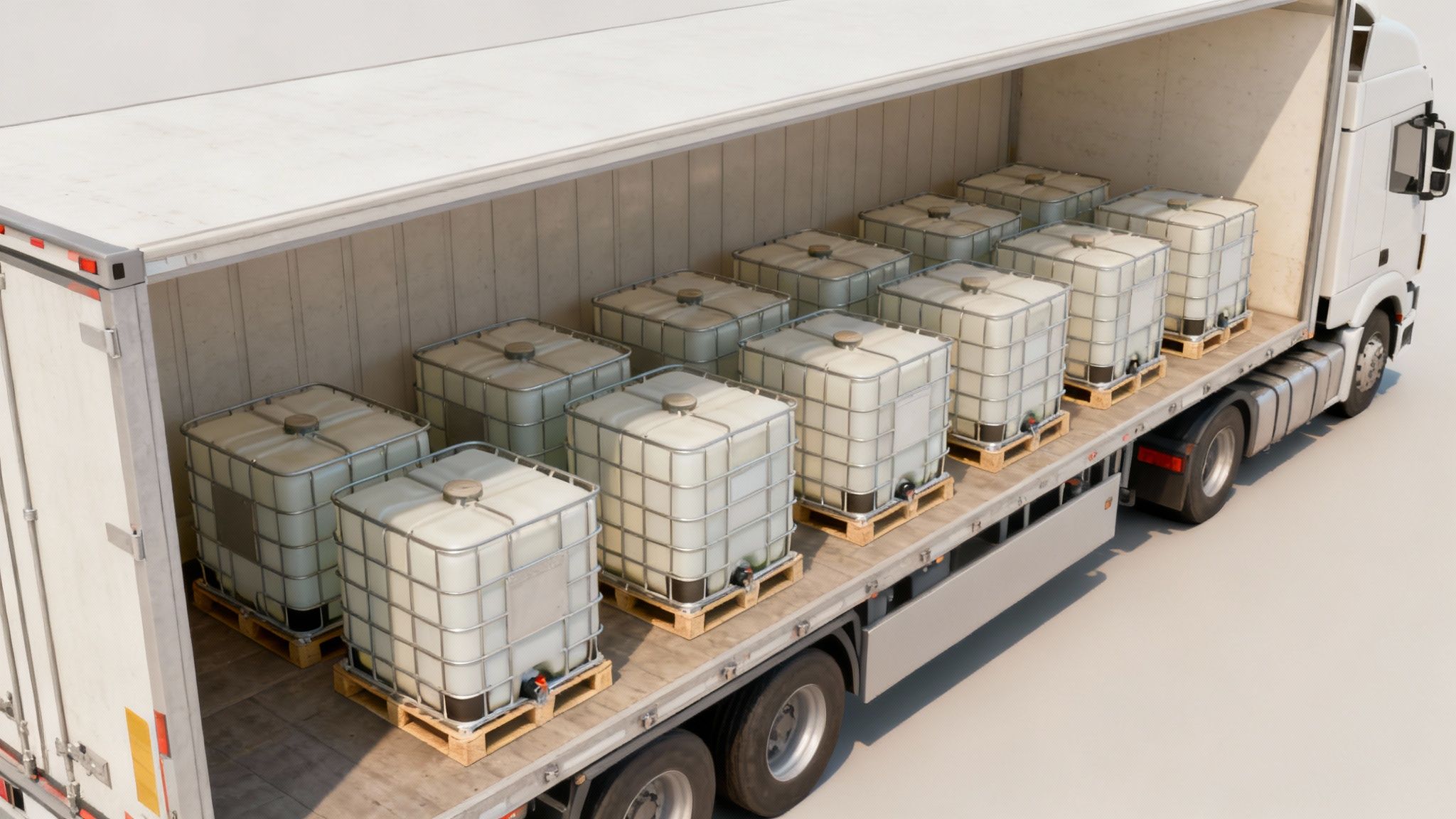Your cart is currently empty!
Dimensions of ibc tote: Key measurements & specs

Written by
in
If you're planning your facility's layout, figuring out shipping logistics, or even just making sure a new piece of equipment will fit, you have to know the exact dimensions of your IBC totes. The two sizes you’ll run into most often are the 275-gallon and 330-gallon totes. They share a standard footprint, but their height is the key difference, which has a big impact on how you can store and transport them.
A Quick Guide to IBC Tote Dimensions
It really helps to have the core specs handy when you're making quick decisions. The main thing to remember is that while the 275 and 330-gallon IBCs have nearly identical bases to fit standard pallet systems, the 330-gallon model stands noticeably taller to hold that extra volume. This is a critical detail for everything from warehouse racking heights and stacking limits to ensuring you have enough clearance in your transport vehicles.
The infographic below gives you a great visual comparison of the footprint, height, and capacity of these common totes.

As you can see, the length and width are consistent, making that height difference the one to watch.
For a more detailed breakdown, the table below summarizes the key measurements and specifications for these industry workhorses. Keep this handy for accurate logistical planning to make sure your space and equipment line up perfectly with the totes you're using.
Standard IBC Tote Dimensions at a Glance
| Specification | 275-Gallon IBC Tote | 330-Gallon IBC Tote |
|---|---|---|
| Footprint (L x W) | 48" x 40" (1219mm x 1016mm) | 48" x 40" (1219mm x 1016mm) |
| Typical Height | 46" (1168mm) | 53" (1346mm) |
| Tare Weight (Empty) | Approx. 135 lbs (61 kg) | Approx. 155 lbs (70 kg) |
| Capacity | 275 US Gallons (1040 Litres) | 330 US Gallons (1250 Litres) |
These are the numbers you'll need for most day-to-day planning, from calculating floor space to estimating shipping weights.
Understanding Common IBC Tote Sizes

If you've spent any time around bulk liquids, you know two sizes of IBC totes pop up more than any others: the 275-gallon (1040-litre) and the 330-gallon (1250-litre) models. These aren't popular by accident. Their design is a masterclass in balancing storage capacity with real-world logistics, and it all comes down to one critical measurement.
The secret is their shared footprint. Both of these common totes are built on a standard 48" x 40" base (that’s about 122 cm x 102 cm). This isn't just a convenient size; it's specifically designed to match the most common pallet dimensions used across North America. This simple decision means they slide right into existing supply chains without any special handling or fuss.
Why the Standard Footprint Is a Game-Changer
Having that consistent base is what makes IBCs so incredibly versatile. It means that whether you're grabbing a 275-gallon or a 330-gallon tote, you know it's going to fit perfectly on your pallet jacks, forklifts, and warehouse racking. This compatibility makes everything easier, from reducing the risk of damage during transport to making the most of every square foot of storage space.
Think about loading a semi-trailer. The predictable footprint allows you to pack the totes in tightly, eliminating wasted space and ultimately driving down the cost of shipping. Warehouse planning becomes a breeze, too. The design even includes built-in grooves for forklift tines, which adds a crucial layer of stability and safety when you're moving them around.
By keeping the base the same, manufacturers figured out they could offer different volumes just by changing the height. It’s a simple, brilliant solution that gives you flexibility in capacity without disrupting the entire logistics system.
For example, the 275-gallon model is incredibly common right across the country, largely because it hits that sweet spot between volume and handling ease. A typical tote of this size will have the 48-inch by 40-inch base and stand about 46 inches tall.
This smart, practical engineering is why these specific 1000 litre (275 gallon) IBCs have become the workhorse for countless industries, from farming to chemical production.
A Detailed Breakdown of Key IBC Measurements

When we talk about IBC totes, everyone focuses on the standard footprint. But for any practical application, you really need to dig deeper into all the specific dimensions of an IBC tote. Getting a handle on every measurement—from the full height down to the inner capacity—is the only way to guarantee a tote will fit seamlessly into your workflow and avoid headaches with parts or equipment that don't match up.
These measurements are more than just numbers on a spec sheet. They directly impact everything from how many totes you can cram into a warehouse to whether they'll work with your existing machinery. For any engineer or facility manager, even a tiny variation can throw a wrench in the works.
External Versus Internal Dimensions
First things first, it's critical to know the difference between the tote's total external size and the dimensions of the plastic bottle inside. The outside measurements tell you if the unit will slide into your warehouse racking or fit onto a truck, while the internal dimensions define its true liquid capacity and whether equipment like mixers or pumps will actually fit inside.
- Overall Height: This is the full measurement from the floor to the very top of the tote, including the pallet base, the cage, and the cap. A standard 275-gallon tote usually stands 46 inches tall, with the larger 330-gallon model coming in at about 53 inches.
- Inner Bottle Dimensions: The actual high-density polyethylene (HDPE) bottle is always a bit smaller than its protective cage. This is the number you need for calculating exact volumes or ensuring a submersible pump has enough clearance.
A common mistake is using the cage dimensions to figure out capacity. For accurate volume planning, always go by the inner bottle's specs, as the cage and pallet add several inches to the total footprint and height.
How Material and Construction Affect Size
The materials used to build an IBC can introduce small but meaningful differences in its dimensions. Across Canada, the Intermediate Bulk Container (IBC) market features a mix of standard sizes and specialized materials built for different jobs. While 275- and 330-gallon totes are by far the most common, you can find capacities anywhere from 110 to 550 gallons for unique applications.
For the typical plastic composite and poly-caged IBCs, the base is almost always 48 inches by 40 inches. However, all-metal IBCs are often a bit wider—around 42 inches—simply due to how they're constructed. You can explore more about these industry standards and variations to get a better sense of how the choice of material influences a tote's final specs.
Navigating IBC Valve and Opening Dimensions

Beyond the tote's overall footprint, the real action happens at the access points: the fill port on top and the discharge valve at the bottom. Getting these connections right is crucial. Trust me, a mismatched fitting can lead to frustrating leaks, downtime, and a mess you don't want to deal with. Knowing these specific measurements ensures the pumps, hoses, and adapters you buy will actually fit.
The top fill port, or lid opening, is thankfully pretty standard. On almost all 275-gallon and 330-gallon totes, you'll find a 6-inch (150mm) diameter opening. This size is more than big enough for easy filling and cleaning, and it accommodates equipment like mixers without any trouble. While most lids are solid plastic, you can also find vented versions for products that might off-gas.
It's the bottom discharge valve where things can get a bit tricky. The valve itself is usually a standard 2-inch (50mm) ball or butterfly type, but the real devil is in the details—specifically, the threads.
Understanding Common Valve Threads
Getting the thread type wrong is probably the most common mistake I see people make, and it's completely avoidable. The two main thread types you’ll run into on standard IBCs are very different and won't work together without the right adapter.
- NPT (National Pipe Thread): This is a tapered American standard thread. The seal is created as the male and female ends are tightened together, wedging them into a tight fit.
- Buttress (or S-Type): This is a much coarser, more robust thread. You'll often see it identified by a code like S60x6. Here's what that means: "S60" refers to the 60mm outer diameter, and "x6" tells you it has a coarse 6mm thread pitch (the distance from the peak of one thread to the next). This is the most common thread found on the European-style totes that are used all over Canada.
Pro Tip: Don't just eyeball it. To be 100% sure, grab a set of calipers and measure the valve's outer diameter and the distance between the thread peaks. An S60x6 thread will measure just about 60mm across and have a 6mm gap between each thread.
This kind of precision is what guarantees a secure, leak-proof connection every time. Understanding these details will help you confidently choose the correct IBC tote fittings and adapters, preventing connection failures before they even happen.
IBC Tote Weight: What You Need to Know for Safe Handling
While an IBC's physical size is key for fitting it into your space, its weight is what really matters for safety, logistics, and legal compliance. You absolutely need to know both the empty (tare) weight and the full (gross) weight before you even think about moving one. This is non-negotiable for safe forklift operation, accurate shipping cost calculations, and making sure your warehouse floor can handle the load.
An empty 275-gallon tote, complete with its steel cage and pallet, typically weighs in at around 135 pounds (61 kg). The bigger 330-gallon model is naturally a bit heavier, usually tipping the scales at about 155 pounds (70 kg) because of its taller cage and larger inner bottle. Think of these as your starting point for any weight calculation.
From Empty to Full: Calculating Gross Weight
The final, loaded weight of an IBC tote comes down to one thing: the density of the liquid inside. Water is the standard benchmark, weighing about 8.34 pounds per US gallon. Using that as a guide gives us a good baseline.
- A full 275-gallon tote filled with water can weigh up to a hefty 2,430 pounds (1,102 kg).
- A full 330-gallon tote with water will be even heavier, coming in at nearly 2,910 pounds (1,320 kg).
Remember, these numbers are for water. If you're storing something denser like syrups, certain chemicals, or drilling mud, that total weight will climb significantly. A tote of molasses, for instance, could easily push past 3,500 pounds.
Safety Tip: Always check the specific gravity of your product and do the math to find the gross weight before lifting or moving an IBC. Overloading a forklift or storage rack is a recipe for disaster, leading to equipment failure, costly spills, and serious injuries.
IBC Tote Weight Comparison
Here's a quick reference table comparing the typical empty and full weights for standard IBC totes, assuming the contents have the same density as water. This helps put the sheer scale of a loaded tote into perspective.
| Capacity | Typical Tare Weight (Empty) | Approximate Gross Weight (Full with Water) |
|---|---|---|
| 275 US Gallon | ~135 lbs (61 kg) | ~2,430 lbs (1,102 kg) |
| 330 US Gallon | ~155 lbs (70 kg) | ~2,910 lbs (1,320 kg) |
As you can see, the weight jumps dramatically once the tote is filled. Planning for the gross weight, not the tare weight, is essential for any handling or storage strategy.
Given just how heavy these containers get, having the right support structure is critical. Investing in the proper heavy duty racks for storage is a smart move to ensure everything is stored securely and accessibly.
How IBC Dimensions Impact Shipping and Storage

The dimensions of an IBC tote are anything but random. They’re the result of smart engineering aimed at squeezing every last bit of efficiency out of the supply chain. If you’re managing a warehouse or logistics, getting a handle on these specs is crucial because they directly affect everything from storage density and shipping costs to overall safety.
The whole system really hinges on that standard footprint. The common 48" x 40" base is no accident—it's designed to fit seamlessly with the standard pallets used across North America. This simple bit of standardization means your existing forklifts and pallet jacks can move totes around without any special gear, making IBCs a go-to solution for just about any bulk liquid handling job.
Optimizing Transport and Warehouse Space
You really see the benefits of these dimensions when you start loading a truck or planning out your warehouse floor. The container’s base takes up about 13 square feet, which allows for some seriously efficient packing arrangements.
A standard 53-foot commercial truck, for example, can often fit between 28 and 56 IBC totes. If you're stacking them, you're looking at moving a massive volume—somewhere in the neighbourhood of 26,500 to 74,200 litres (roughly 7,000 to 19,600 gallons) in a single trip. That’s efficiency you can measure.
This knack for optimizing space is just as valuable in the warehouse, where going vertical is the name of the game.
- Static Stacking: In a warehouse setting, on a solid and level floor, you can usually stack most UN-rated IBCs two or even three high when they're full.
- Dynamic Stacking: During transport—whether on a truck or a ship—it’s best practice to limit stacks to two high. This keeps the load stable and prevents dangerous shifting on the move.
A word of caution: always check the tote's specific UN rating label. It will tell you the maximum stacking load, and you should never exceed it. Pushing that limit is a recipe for a collapsed cage, a dangerous spill, and a very expensive cleanup.
It's not just about packing things tight. Following the Transport Chain of Responsibility ensures everyone involved is on the hook for safe loading and transport. Combining proper handling with the right secondary containment, like a dependable spill containment pallet, is just plain good sense for a safe and compliant workplace.
Frequently Asked Questions About IBC Tote Dimensions
Got a question about IBC tote dimensions? You're not alone. Here are some quick, straightforward answers to the most common queries we get. These are the practical details that can make or break a project, so getting them right is key.
Think of this as your cheat sheet for solving those small but crucial measurement puzzles that can stop an operation in its tracks.
Are the Dimensions of a Food-Grade IBC Tote Different From a Standard One?
No, you can expect the outside dimensions to be identical. A food-grade tote and a standard industrial tote of the same capacity will have the same footprint and height. The real difference is on the inside.
The inner bottle of a food-grade tote is made from virgin, FDA-approved, BPA-free high-density polyethylene (HDPE). The external cage and pallet, however, stick to the standard sizes. This is done on purpose so they work with all the same equipment—forklifts, pallet jacks, racking—you're already using.
Do All 275-Gallon IBC Totes Have the Same Footprint?
For the most part, yes. The vast majority of 275-gallon totes are built on a standard 48" x 40" footprint, which matches the most common pallet size in North America. For general planning and logistics, you can rely on this dimension.
However, there can be slight variations from one manufacturer to another. If you're working with extremely tight clearances or fabricating custom storage, it's always a good idea to double-check the official spec sheet from the manufacturer just to be safe.
How Can I Identify a 275-Gallon vs a 330-Gallon Tote?
The quickest way to tell them apart is by looking at their height. Both totes almost always share the same 48" x 40" base, so the giveaway is how tall they are.
- A standard 275-gallon tote is about 46 inches tall.
- A 330-gallon tote is noticeably taller, standing around 53 inches high.
So, if you see a tote that looks a bit stretched vertically, it’s almost certainly the larger 330-gallon model.
How Do You Properly Measure an IBC Tote Valve?
Measuring an IBC valve correctly comes down to two things: its diameter and its thread type. The diameter is usually 2 inches on most common totes.
The tricky part is the thread. You'll need to measure the distance from the peak of one thread to the next to find the pitch. For example, a very common S60x6 Buttress thread has a 6mm pitch. Using a set of calipers is the best way to get a precise measurement. This little bit of effort ensures you buy the right adapter and get a connection that won't leak.
For a reliable supply of IBC totes, parts, and expert advice tailored to your specific needs, trust IBC Tanks Canada. Find the right containers and fittings for your operation at https://ibctanks.ca.
Leave a Reply